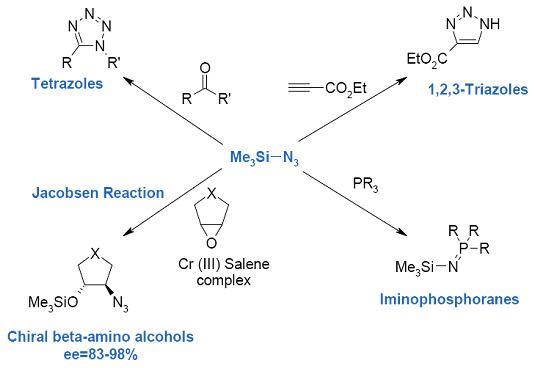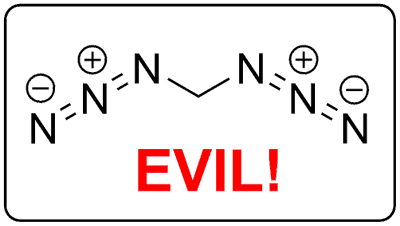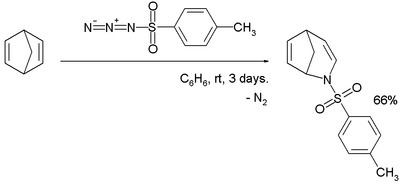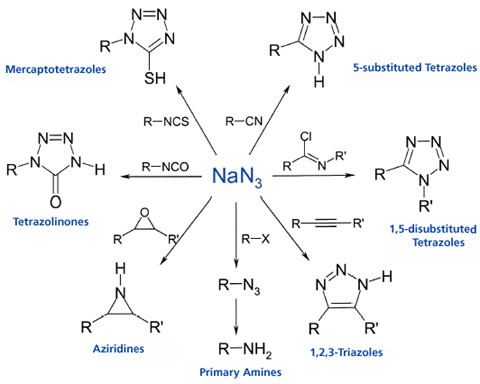 | ||
Azide x j swey god the devil
Azide is the anion with the formula N−
3. It is the conjugate base of hydrazoic acid (HN3). N−
3 is a linear anion that is isoelectronic with CO2, NCO−, N2O, NO+
2 and NCF. Per valence bond theory, azide can be described by several resonance structures; an important one being
Contents
- Azide x j swey god the devil
- Azide x drama x j swey x nitrite non believer official music video
- Inorganic azides
- Organic azides
- DuttWormall reaction
- Applications
- Detonators and propellants
- Other
- Safety
- References

Azide x drama x j swey x nitrite non believer official music video
Inorganic azides

Sodium azide is made industrially by the reaction of nitrous oxide, N2O with sodium amide in liquid ammonia as solvent:
N2O + 2 NaNH2 → NaN3 + NaOH + NH3
Many inorganic azides can be prepared directly or indirectly from sodium azide. For example, lead azide, used in detonators, may be prepared from the metathesis reaction between lead nitrate and sodium azide. An alternative route is direct reaction of the metal with silver azide dissolved in liquid ammonia. Some azides are produced by treating the carbonate salts with hydrazoic acid.
Organic azides

The principal source of the azide moiety is sodium azide. As a pseudohalogen compound, sodium azide generally displaces an appropriate leaving group (e.g., Br, I, OTs) to give the azido compound. Aryl azides may be prepared by displacement of the appropriate diazonium salt with sodium azide, or trimethylsilyl azide; nucleophilic aromatic substitution is also possible, even with chlorides. Anilines and aromatic hydrazines undergo diazotization, as do alkyl amines and hydrazines.

Appropriately functionalized aliphatic compounds undergo nucleophilic substitution with sodium azide. Aliphatic alcohols give azides via a variant of the Mitsunobu reaction, with the use of hydrazoic acid. Hydrazines may also form azides by reaction with sodium nitrite:
PhNHNH2 → PhN3
Alkyl or aryl acyl chlorides react with sodium azide in aqueous solution to give acyl azides, which give isocyanates in the Curtius rearrangement.

The azo-transfer compounds, trifluoromethanesulfonyl azide and imidazole-1-sulfonyl azide, are prepared from sodium azide as well. They react with amines to give the corresponding azides:
RNH2 → RN3Dutt–Wormall reaction
A classic method for the synthesis of azides is the Dutt–Wormall reaction in which a diazonium salt reacts with a sulfonamide first to a diazoaminosulfinate and then on hydrolysis the azide and a sulfinic acid.
Inorganic azides
Azide salts can decompose with release of nitrogen gas as discussed under Applications. The decomposition temperatures of the alkali metal azides are: NaN3 (275 °C), KN3 (355 °C), RbN3 (395 °C), and CsN3 (390 °C). This method is used to produce ultrapure alkali metals.
Protonation of azide salts gives toxic hydrazoic acid in the presence of strong acids:
H+ + N−3 → HN3
Azide salts may react with heavy metals or heavy metal compounds to give the corresponding azides, which are more shock sensitive than sodium azide alone. They decompose with sodium nitrite when acidified. This is a method of destroying residual azides, prior to disposal.
2 NaN3 + 2 HNO2 → 3 N2 + 2 NO + 2 NaOHMany inorganic covalent azides (e.g., chlorine, bromine, and iodine azides) have been described.
The azide anion behaves as a nucleophile; it undergoes nucleophilic substitution for both aliphatic and aromatic systems. It reacts with epoxides, causing a ring-opening; it undergoes Michael-like conjugate addition to 1,4-unsaturated carbonyl compounds.
Azides can be used as precursors of the metal nitrido complexes. Azide complexes thus is induced to release N2, generating a metal complex in unusual oxidation states (see high-valent iron).
Organic azides
Organic azides engage in useful organic reactions. The terminal nitrogen is mildly nucleophilic. Azides easily extrude diatomic nitrogen, a tendency that is exploited in many reactions such as the Staudinger ligation or the Curtius rearrangement or for example in the synthesis of γ-imino-β-enamino esters.
Azides may be reduced to amines by hydrogenolysis or with a phosphine (e.g., triphenylphosphine) in the Staudinger reaction. This reaction allows azides to serve as protected -NH2 synthons, as illustrated by the synthesis of 1,1,1-tris(aminomethyl)ethane:
3 H2 + CH3C(CH2N3)3 → CH3C(CH2NH2)3 + 3 N2In the azide alkyne Huisgen cycloaddition, organic azides react as 1,3-dipoles, reacting with alkynes to give substituted 1,2,3-triazoles. This reaction is very popular in click chemistry.
Another azide regular is tosyl azide here in reaction with norbornadiene in a nitrogen insertion reaction:
Applications
About 250 tons of azide-containing compounds are produced annually, the main product being sodium azide.
Detonators and propellants
Sodium azide is the propellant in automobile air bags. It decomposes on heating to give nitrogen gas, which is used to quickly expand the air bag:
2 NaN3 → 2 Na + 3 N2Heavy metal salts, such as lead azide, Pb(N3)2, are shock-sensitive detonators which decompose to the corresponding metal and nitrogen, for example:
Pb(N3)2 → Pb + 3 N2Silver and barium salts are used similarly. Some organic azides are potential rocket propellants an example being 2-Dimethylaminoethylazide(DMAZ).
Other
Because of the hazards associated with their use, few azides are used commercially although they exhibit interesting reactivity for researchers. Low molecular weight azides especially are considered hazardous and are avoided. In the research laboratory, azides are precursors to amines. They are also popular for their participation in the "click reaction" and in Staudinger ligation. These two reactions are generally quite reliable, lending themselves to combinatorial chemistry.
The antiviral drug zidovudine (AZT) contains an azido group. Some azides are valuable as bioorthogonal chemical reporters.
